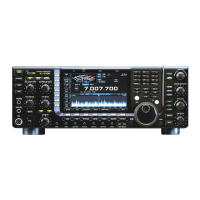D Connecting a non-Icom linear amplifier
R WARNING!
Set the transceiver output power and linear ampli-
fier ALC output level after referring to the linear
amplifier instruction manual.
TheALCinputlevelmustbeintherange0Vto
–4V.Thetransceiverdoesnotacceptpositivevolt-
age. Non-matched ALC and RF power settings
could overheat or damage the linear amplifier.
The maximum signal level of [RELAY] jack is
16V/0.5ADCwithinitialsetting,and250V/200mA
with “MOSFET” setting (see page 12-8 for details).
Useanexternalrelayunitifyournon-Icomlinear
amplifier requires control voltage and/or current
greater than specified.
When using a linear amplifier that has a time delay
between receiving and transmitting, a high SWR
might cause the linear amplifier to malfunction. To
prevent this, slow the TX Delay the “TX Delay (HF),
(50M)” settings in the Others Set mode.
(pp. 12-12, 12-13)
SET > OTHERS > TX Delay (HF), (50M)
■ Linear amplifier connections
D Connecting the IC-PW1/EURO
2-8
2
INSTALLATION AND CONNECTIONS
RF OUTPUT RF INPUT
SEND
ALC
50 Ω
coaxial cable
TransceiverANT1
ALC
RELAY
To an
antenna
Non-Icom linear amplifier
To an
antenna
ACC-1
ANT
ANT1
ACC 2
INPUT1
REMOTE
EXCITER
1
1&2
GND
GND
IC-PW1/EURO
AC outlet
(Non-European versions : 100–120/200–240 V
European version : 230 V)
Ground
Transceiver
REMOTE
Remote control cable (supplied with the IC-PW1/EURO)
ACC cable (supplied with the IC-PW1/EURO)
Be sure to connect the cable
to the 7-pin ACC 2 jack.
Coaxial cable
(supplied with the
IC-PW1/EURO)
Coaxial cable*
*Optional

